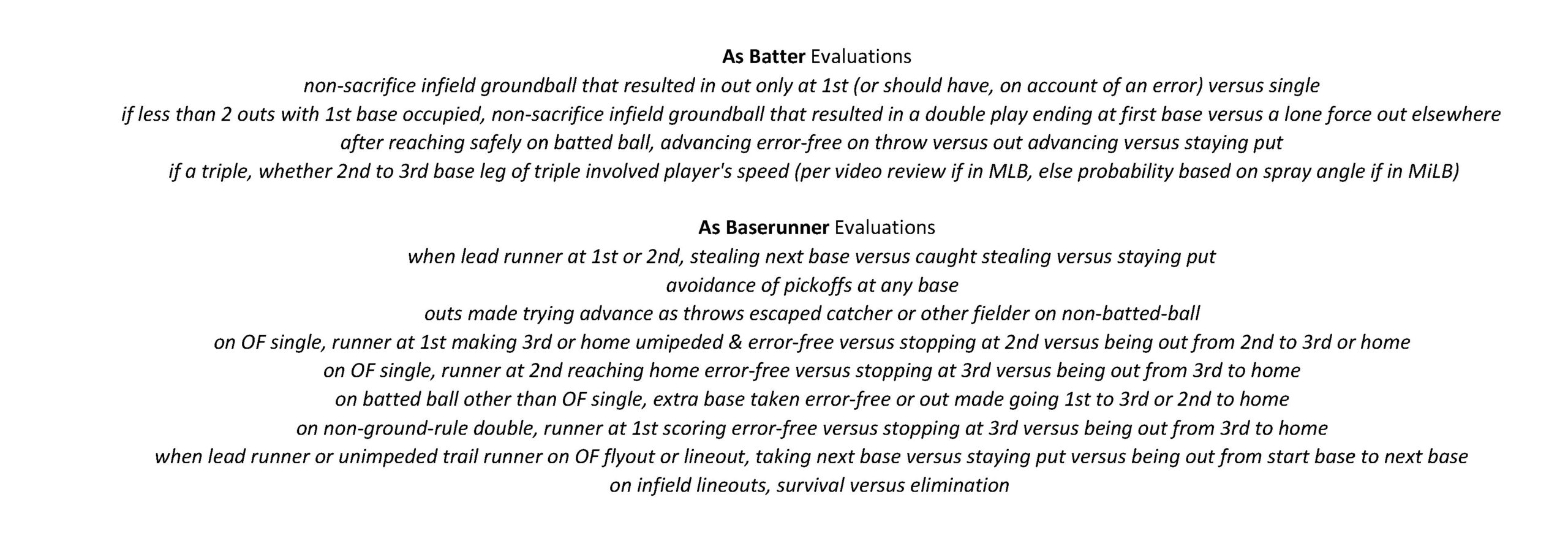Max Clark's fantasy baseball prospect outlook, sleeper potential for dynasty leagues. Matt uses his custom suite of fundamentals-rooted evaluation tools.
From August through September of 2022, I watched Tigers center field prospect Max Clark play around a dozen games when I attended the USA Baseball 18 Under (18U) National Team Camp through completion of the WBSC (World Baseball and Softball Confederation) 18U Baseball World Cup at various MLB complex sites along the central to southern Gulf coast of Florida.
After retelling what I saw then ahead of his 2023 senior and MLB Draft season, I will share what the FaBIO plate profile and Offensive Running Rating models have to say about the pro today.
In this piece, I will analyze Clark's current production to determine his dynasty fantasy baseball outlook.
Be sure to check all of our fantasy baseball lineup tools and resources:- Fantasy baseball trade analyzer
- BvP matchups data (Batter vs. Pitcher)
- PvB matchups data (Pitcher vs. Batter)
- Who should I start? Fantasy baseball comparisons
- Daily MLB starting lineups
- Fantasy baseball closer depth charts
- Fantasy Baseball live scoreboard
- Fantasy baseball injury reports
August Through September 2022 Live Looks
When Clark first entered the USA 18U player development cycle earlier that summer of 2022, he was considered by many to be the No. 1 prospect in the 2023 amateur draft class. By the end of it, he had fallen a handful of spots from the top.
While with USA 18U in Florida, Clark's beyond plus athleticism was on full display in the outfield and on the basepaths. He ranged, threw, ran, and stole impressively with but one mishap on a flyball he likely lost in the Gulf Coast skies that require a difficult adjustment for non-locals like him.
The non-batted ball outcomes also graded out very well. But the bat played emptier and did not stand out as even half-plus relative to other camp participants or final tournament roster players.
For perhaps the first time as a more mature amateur, Clark did not stand out as one of the very top players on his squad or contribute at a higher level to team success. This clearly frustrated him. Hordes of scouts and other key MLB baseball operations personnel were on hand to witness these events.
Brief Explanation of the FaBIO Model
My Fielding- and Ballpark-Independent Outcomes (FaBIO) evaluation model sorts every plate appearance into one of 12 outcome bins (BB+HBP, K, IFFB, Pull-Third OFFB, Center-Third OFFB, Oppo-Third OFFB, Pull-Third LD, Center-Third LD, Oppo-Third LD, Pull-Third GB, Center-Third GB, Oppo-Third GB) and charges the pitcher and batter with their league's mean runs value for said particular event that season.
Dividing a batter's total number of expected runs by plate appearance (PA) yields expected runs per PA that can be percentile ranked relative to the league mean and standard deviation for that parameter amongst league batter qualifiers to arrive at their Overall Rating.
Its three subcomponents of BB+HBP Rating (based on BB+HBP per PA), Strikeout Avoid Rating (K Avoid, based on K per PA), and Batted Ball Profile Rating (expected runs per batted ball) are also reported to identify the path the batter traveled to reach their Overall Rating.
Overall Rating and Batted Ball Profile Rating of batters should be considered power- and speed-neutralized metrics since the real-world runs value of a single batter's typical OFFB or LD varies with their strength, and the expected runs value of their typical GB varies with their speed.
To better understand the Path to Batted Ball Profile, we will also examine percentile ratings for select batted ball event types (on a per-batted ball basis). To check how well expected batted ball outcomes matched real-world ones, we will compute percentile ratings for hits (AVG) and isolated power (ISO, or simply extra bases) on batted balls (recognizing full well that these two parameters are neither fielding- nor ballpark-independent outcomes).
What most explains a batter's ability to generate hits (AVG) on batted balls is any LD, IFFB avoidance, Pull-Third OFFB, and Pull-Third GB avoidance. What most explains their ability to generate extra bases (ISO) on batted balls is any OFFB, Pull-Third OFFB, Pull-Third LD, and IFFB avoidance.
A percentile rating of 97 amounts to plus-plus (two standard deviations above the mean), 84 is plus (one standard deviation above the mean), 69 is half plus, 50 is average, 31 is half minus, 16 is minus, and three is minus-minus.
A new addition to this suite of evaluation models is Offensive Running Rating. This tool quantifies how each relevant inning's run expectancy was impacted by the player's action or inaction as either a batter or baserunner on very specific types of plays that are more likely to involve one or both of their speed or offensive running technique, plus acumen.
The evaluated batter and baserunner events are summarized in the graphic.
Prospect Analysis: Max Clark
Evolution of Pro Plate Profile
LSU teammates Paul Skenes and Dylan Crews had their names called in the first two picks of the 2023 MLB Draft with nearer-slot signing bonuses in place. This left the Detroit Tigers with maximum bonus pool leverage and two clearer moves to decide between.
One was to bid up the top college position player of the class, Wyatt Langford, still more beyond what the bonus-pool-limited Rangers already had. Option two was to underslot a preferred high schooler and use the pocketed bonus pool savings to steer a second favorite prep down to a later pick slot with a larger bonus offer that only a few clubs could top before that turn came up.
The Tigers chose the latter option, with Clark receiving an undershot bonus of $7.0 million at pick three. Kevin McGonigle was later revealed as the back-end over-slot bonus player at overall pick No. 37. Clark and McGonigle would be joined at the hip from there onward.
Clark logged 55 PA with the rookie Florida Complex League affiliate before the duo walked across the Lakeland complex to the low-A full-season affiliate, with which Clark would get another 65 plate trips. Clark lost rather much K Avoid, OFFB, and Pull OFFB over that short trip, but ended the full debut with a promising 90 Overall that featured an average K Avoid sandwiched between matching 93s at BB+HBP and Batted Ball Profile.
Clark produced an ordinary (50) AVG for such a stout 98 LD/81 IFFB Avoid/67 Pull GB Avoid hit trio. He also experienced a big decline against Same-Handed Pitchers BB+HBP and K Avoid while with A club, raising awareness of possible platoon struggles ahead for the LHB against lefthanded pitchers.
Clark returned to the Low-A affiliate to open 2024 and turned in 328 more PA there. While there, he raised K Avoid 1.5 standard deviations (SDs) versus the 2023 stint with the club. He produced relatively much (78) AVG on Batted Balls despite an LD rating subpar with that affiliate.
LD rebounded over the next and final 157 PA in High A as AVG stayed circa plus. Launch (per GB Avoid and OFFB) sank still more in High-A, but a relatively high prevalence of (54) Pull OFFB empowered a half plus (69) ISO output. BB+HBP and K Avoid were each down a fuller standard deviation in High-A versus the 2024 Low-A marks, as Clark faced a higher general caliber of pitcher than before.
Net changes from 2023 to 2024 involved BB+HBP declining by a SD, K Avoid rising not quite a full SD, and AVG and ISO outcomes getting louder despite his Batted Ball Profile falling by a full SD. Same-Handed Pitchers outcomes proved quite good in 2024, with Oppo-Handed Pitchers ones being the relative weakness in High-A.
Thirteen plate trips in 2025 MLB spring training games produced decent enough non-batted-ball outcomes but poorer batted-ball profile fundamentals and less impactful hit or extra-base production.
The relative highlight of the bonus MLB exhibition time was that the Clark survived a potentially traumatic collision with outfielder Justyn-Henry Malloy when the High-A center fielder dove headlong trying to snare a ball in the left-center alley.
Evolution of Pro Offensive Running
The very athletic Clark surprisingly registered just half a minus as an offensive runner in the combined smaller-sample 2023 pro debut, and about the same whether as Batter or as Baserunner.
A first full pro season of 2024 featured clear improvements as he wound up one percentile point shy of a plus Offensive Running Rating for the whole campaign. Between the player's athleticism and obsessive dedication to becoming a better baseball player, we should expect him to improve gradually in this realm.
Dynasty Fantasy Baseball Focus
Today, Clark is viewed as an athletic, everyday regular MLB L/L center or right fielder with half-to-perhaps full-plus hit ability and average power.
Upon return to High-A to begin 2025, areas of developmental focus (milestones to reach to warrant promotion to AA) include improving BB+HBP and K Avoid outcomes versus opposite-handed pitchers (which he disproportionately faces as a LHB) relative to how he ended 2024 there, raising BB+HBP against all pitchers to increase second base steal opportunities.
The left-handed batter should aim to limit pull-third grounders to further boost hit frequency (AVG) on batted balls. For now, he should maintain a relatively low launch bias to the batted ball profile (GB Avoid and OFFB each fairly below 50) but with a higher than expected Pull OFFB for the OFFB to maximize hit (AVG) and extra bases (ISO) potential on the relatively scarcer OFFB.
Clark is likelier to end 2025 in Double-A or get a late cup of coffee in Triple-A than make a surprise 2025 MLB debut. For that improbability to materialize, he would need to emerge as a player who could fill a niche role on a postseason roster bench superior to more experienced candidates for the spot (think 2024 playoff bullpen Jackson Jobe).
Download Our Free News & Alerts Mobile App
Like what you see? Download our updated fantasy baseball app for iPhone and Android with 24x7 player news, injury alerts, sleepers, prospects & more. All free!

More Fantasy Baseball Advice





 RADIO
RADIO




























